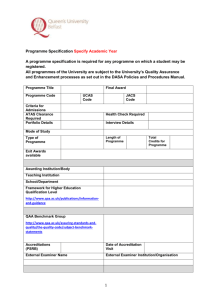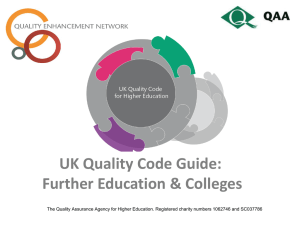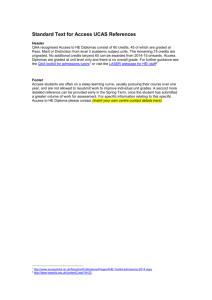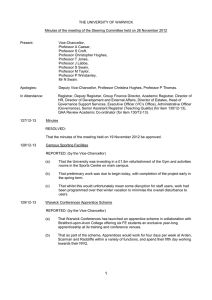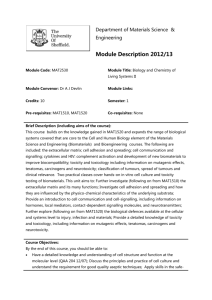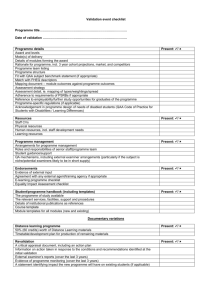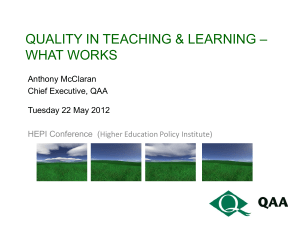What Price Teaching Quality? Mark Harrison and Ben Lockwood
advertisement
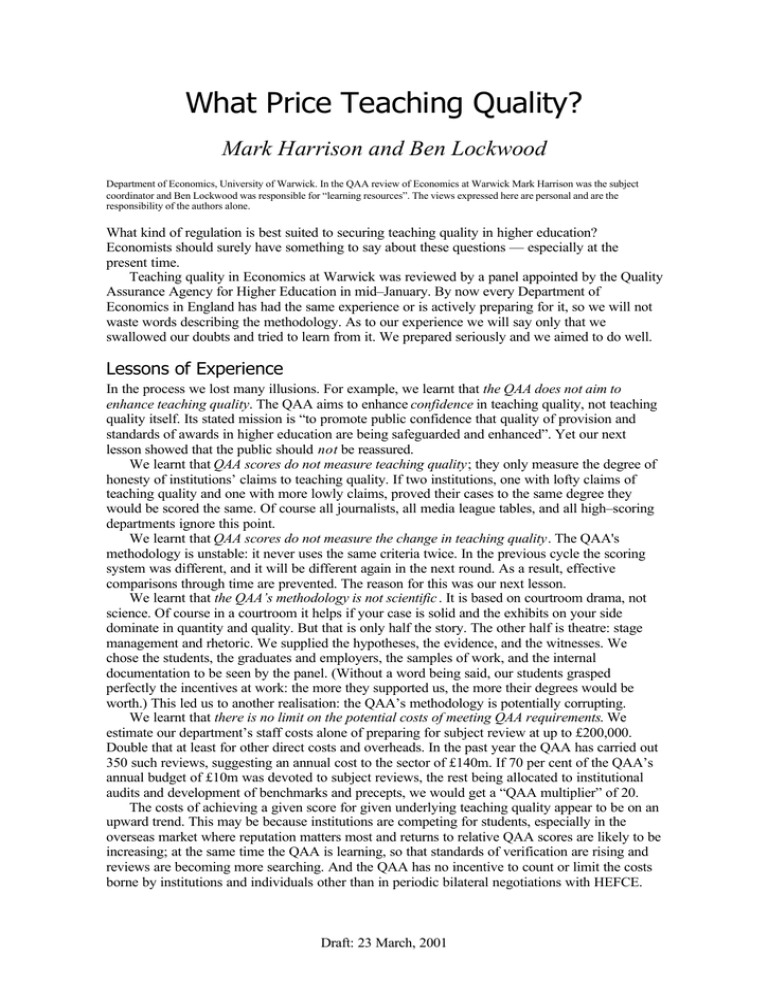
What Price Teaching Quality? Mark Harrison and Ben Lockwood Department of Economics, University of Warwick. In the QAA review of Economics at Warwick Mark Harrison was the subject coordinator and Ben Lockwood was responsible for “learning resources”. The views expressed here are personal and are the responsibility of the authors alone. What kind of regulation is best suited to securing teaching quality in higher education? Economists should surely have something to say about these questions — especially at the present time. Teaching quality in Economics at Warwick was reviewed by a panel appointed by the Quality Assurance Agency for Higher Education in mid–January. By now every Department of Economics in England has had the same experience or is actively preparing for it, so we will not waste words describing the methodology. As to our experience we will say only that we swallowed our doubts and tried to learn from it. We prepared seriously and we aimed to do well. Lessons of Experience In the process we lost many illusions. For example, we learnt that the QAA does not aim to enhance teaching quality. The QAA aims to enhance confidence in teaching quality, not teaching quality itself. Its stated mission is “to promote public confidence that quality of provision and standards of awards in higher education are being safeguarded and enhanced”. Yet our next lesson showed that the public should not be reassured. We learnt that QAA scores do not measure teaching quality; they only measure the degree of honesty of institutions’ claims to teaching quality. If two institutions, one with lofty claims of teaching quality and one with more lowly claims, proved their cases to the same degree they would be scored the same. Of course all journalists, all media league tables, and all high–scoring departments ignore this point. We learnt that QAA scores do not measure the change in teaching quality. The QAA's methodology is unstable: it never uses the same criteria twice. In the previous cycle the scoring system was different, and it will be different again in the next round. As a result, effective comparisons through time are prevented. The reason for this was our next lesson. We learnt that the QAA’s methodology is not scientific . It is based on courtroom drama, not science. Of course in a courtroom it helps if your case is solid and the exhibits on your side dominate in quantity and quality. But that is only half the story. The other half is theatre: stage management and rhetoric. We supplied the hypotheses, the evidence, and the witnesses. We chose the students, the graduates and employers, the samples of work, and the internal documentation to be seen by the panel. (Without a word being said, our students grasped perfectly the incentives at work: the more they supported us, the more their degrees would be worth.) This led us to another realisation: the QAA’s methodology is potentially corrupting. We learnt that there is no limit on the potential costs of meeting QAA requirements. We estimate our department’s staff costs alone of preparing for subject review at up to £200,000. Double that at least for other direct costs and overheads. In the past year the QAA has carried out 350 such reviews, suggesting an annual cost to the sector of £140m. If 70 per cent of the QAA’s annual budget of £10m was devoted to subject reviews, the rest being allocated to institutional audits and development of benchmarks and precepts, we would get a “QAA multiplier” of 20. The costs of achieving a given score for given underlying teaching quality appear to be on an upward trend. This may be because institutions are competing for students, especially in the overseas market where reputation matters most and returns to relative QAA scores are likely to be increasing; at the same time the QAA is learning, so that standards of verification are rising and reviews are becoming more searching. And the QAA has no incentive to count or limit the costs borne by institutions and individuals other than in periodic bilateral negotiations with HEFCE. Draft: 23 March, 2001 2 The latter bears the institutional costs, but not the costs that institutions pass on to individuals in unpaid overtime, sleepless nights, and disrupted career development. Finally, we learnt that the QAA methodology is damaging to incentives. There was teaching quality long before the QAA. Teaching quality was founded traditionally on the intrinsic motivations of scholarship. Increasingly we are forced to do things because the QAA says so and threatens us if we don’t, not because scholarship demands it. Intrinsic motivations have been devalued and increasingly replaced by responses to monitoring and external incentives. But even the extrinsic incentives are weakened by a defective monitoring system and the low likelihood of a true judgement of underlying teaching quality being reached. In the long run there is a ratchet effect: the harder we try today the more will be expected of us tomorrow, so why bother? Signs of Revolt We joined with other colleagues to write about some of these experiences in The Guardian Higher on 30 January 2001. Following publication, our negative account of the QAA experience was abundantly confirmed by a flood of letters and emails from colleagues in many departments, disciplines, and universities around the country, invariably supportive, often angrily so. From these responses we concluded that our article spoke for the “silent majority” that has borne the disproportionate costs of the QAA regime. QAA chief executive John Randall replied on 6 February, suggesting, absurdly, that anyone truly concerned for teaching quality would set the marginal costs of a QAA inspection at zero. But our own conclusions were reinforced by an analysis of 665 QAA reports from the 1998/2000 inspection rounds, carried out by Roger Cook of Napier University and reported in The Times Higher on 2 March. He found that subject review grades were “too closely” correlated with institutional resources, and the rising trend of grades through time was found to be associated in part with instiutitions’ “learning exactly how to write [self–created aims and objectives] so as to maximise their grades”. Strengthened by such considerations we have pressed our views at Warwick on faculty boards, in other departments, and to university officers, and we have heard of similar moves at other institutions, most notably at LSE where on 14 March the Academic Board adopted a wide– ranging resolution essentially proposing secession from the QAA mechanism at the level either of the institution or of the Russell Group. What’s Wrong with the Market? Information bias We are not going to return to a world without regulation, and that is probably a good thing. The reason is that in the market for higher education services there is a fundamental information asymmetry: we know best. Neither students nor most employers know as much as us academics about what we really do when we teach our own subject. For this reason demands for quality regulation are inevitable and we should acknowledge them as legitimate. On the other hand it is not appropriate to require the same level of regulation on academics as on lawyers or doctors. We do not have the power to kill our clients or lose them their freedom. We should reject the idea that high levels of complaints against hospitals and solicitors somehow justify the extension of top–heavy regulation from legal services and the NHS to universities. A monopoly regulator What is the underlying problem with the QAA? If the problem is regulation that is excessive and distorting, one solution might be to decree that the QAA should regulate less, and more intelligently. More in tune with the way economists think might be to define the problem in terms of the structure of the market in regulation services. The problem is that the QAA has been set up as a monopoly regulator. As such it faces an incentive to overregulate. 3 Monopolists maximise profits by restricting output and raising prices. The QAA’s “output” consists of quality certifications. 1 The supply is restricted and the price raised by imposing performance criteria, benchmarks, precepts, and so on, that are excessively defined. The greater the quantity and complexity of rules, the more rents the QAA can extract from HEFCE. At the same time, as in the classical case of monopoly, a large deadweight loss is imposed on society in increased higher education costs. In the QAA we have created a monopoly with an extraordinary power to extract a surplus from society. Think of the QAA as a revenue–maximiser, or as a profit–maximiser with zero marginal internal costs. This is because the QAA’s control over the HE sector’s resources is increasing in its outlays. Then think of the social costs of regulation as the QAA’s budget combined with the regulation costs imposed on the higher education sector. Every new benchmark and precept developed by the QAA increases its power to extract a rent from HEFCE, while imposing an unaccounted regulation cost on HEFCE–funded institutions. The only limit on the combined costs that QAA is able to impose upon the sector is set by the resistance of UUK to the complete dissipation of its HEFCE funding by John Randall’s Merry Men and Women, who act as Robin Hood in reverse. What Is To Be Done? Solution 1: regulate the monopolist? If the problem is a monopoly, there are two solutions. One is to impose a rule on the monopolist. An appropriate rule might compel the monopolist to offer a competing product, say, a lower level of regulation that could be applied to institutions that met threshold quality criteria. Think of lower–level regulation as an audit of institutional procedures for course approval, review, and external scrutiny, plus student final outcomes and graduate and employer satisfaction. An institution that met audit–based requirements could escape scrutiny of student experiences and outcomes at each learning opportunity and progression point. The latter would be applied only to institutions that fell below the audit threshold. Pro Under this scheme the most burdensome reviews would be undertaken selectively. It would greatly reduce regulation costs, while preserving guaranteed minimum standards. Con On the negative side institutions with performance measures below critical values would face strong incentives to invest resources in pushing them up and in lobbying the regulator to grant exemptions on special–case grounds. Incentives for higher–performing institutions to pursue further improvement would be few, so quality might level downwards over time, institutions clustering just above the threshold. The regulator would face an incentive to ratchet upwards the approval standards on both its products (audit–based and review–based approval) in parallel. These disadvantages are inherent in any system based on externally imposed thresholds. Solution 2: liberalise the market? Another answer would be to create a duopoly or even a free market in quality certifications. Regulators competing for custom would offer certifications customised to the varying needs of institutions and differentiated by the level of regulation offered. Institutions could choose the level appropriate to their needs. Those with high initial reputation could choose light regulation based on audit. Those with a reputation deficit could make it up by choosing a more intrusive inspection regime; some would voluntarily invest in subject review–type inspection and would buy an advantage over those that did not. 1 On monopoly regulation under dictatorship see Ronald Wintrobe (1998), The Political Economy of Dictatorship, 207. Wintrobe’s regulators collect bribes; here they collect fees from HEFCE. 4 Pro Again, such an approach would greatly reduce regulation costs. There would be no thresholds, so no incentives to distort audit indicators around threshold values, and no one to lobby for exemption from thresholds. Institutions with high quality would have an incentive to maintain it while buying light regulation. The most burdensome reviews would be undertaken voluntarily and no one would have a right to complain. Con Because the choice of regulation level would lie with institutions, minimum standards would not be forcefully guaranteed. Regulators’ competition for business would create an incentive to allow standards to drift downward — the opposite direction from the previous case. There might be a loss to the international reputation of the sector because the activity of a government monopoly regulator is easier to understand from a distance than a “market” with several competing regulators. Teaching Quality in the US The vast and diverse US system of higher education functions without any kind of government accreditation or “quality assurance” at all. Rather, the print media provide a number of rankings of US universities of given types, widely read by prospective college students and their parents. One of the best-known, provided by US News and World Report, ranks national universities (those offering postgraduate degrees with a full range of undergraduate majors), and liberal arts colleges (which emphasise undergraduate education) separately, using sixteen different measures under the broad headings of academic reputation, student drop–out rate, faculty resources, selectivity, financial resources, final degree performance, and alumni giving (faculty salaries enter positively into the rankings an indicator of faculty resources!). Alternative rankings are also published by Time, Newsweek , and Money Magazine among others.2 Pro It is important to note that the data behind the rankings are either already in the public domain or can be provided at low cost by universities. Thus the cost to the sector of participating in the ranking system is virtually zero. Effectively this is a variant of solution 2 above: there is a free market in regulators, and regulation is so cheap that each university can contract with all of them. However, no regulators offer rankings based on inspection of institutions’ internal procedures and processes, as opposed to statistical data. Con Interestingly, the criticisms made of the system in the US are consonant with the “cons” of solution 2 above. First there is evidence that, given the increasing popularity of these rankings, universities “massage” the data provided to ranking publications (Wall Street Journal, 5 April and 12 October, 1995). Second, many publishers of rankings are criticised for not explaining their methodology, or changing it too often. Third, and perhaps not surprisingly in view of the above, most prospective students do not base their decisions on rankings: “A 1997 survey of college freshmen released by the Higher Education Research Institute reported that, of the 251,232 freshmen surveyed, only 8.6 percent considered colleges’ rankings in national magazines to be ‘very important’ when selecting a college”.3 In particular non-traditional students, constrained from moving by family and financial reasons, do not consider many universities. Conclusion That private universities in the US are so lightly regulated is perhaps not surprising; the bigger surprise from a UK perspective is that public universities, mostly funded by state governments, 2 Links to many are at http://gateway.library.uiuc.edu/edx/rankings.htm. Glen Kersten (2000), “Grading on the Curve: College Ratings and Rankings”, at http://www.sls.lib.il.us/reference/por/features/99/collrank.html. 3 5 are not more heavily regulated. Nevertheless, while regulation is “light”, the quality of teaching in US universities is not perceived (e.g. by students from Asia ) to be below that of UK universities. One reason may be that teaching performance is a more important input into tenure and promotion decisions than in the UK, especially in liberal arts colleges. Behind this is probably the fact that students pay fees, some of them very high. There is a lesson here for the UK. In spite of the disadvantages of top–up fees, one beneficial side-effect might be less need for intrusive and bureaucratic “quality assurance”. Considering the other alternatives, one thing we know for sure is that what we have today is worse. There is no panacea, but there is a system that is absolutely guaranteed to disable higher education for the next generation: the one we’ve got now. Higher education must find a voice to speak out against it. Universities should join urgently in an approach to HEFCE to demand reform. STOP PRESS On 21 March Education and Employment Secretary David Blunkett announced plans to reduce the burden of higher education quality review by 40 per cent or more: “departments which have achieved good scores in the current round (at least three scores of 3 and three scores of 4 on the six factors assessed) will be exempt from external review in the next round — apart from a small proportion which would be sampled by agreement and would provide the necessary benchmarking of good practice”. A victory of sorts, or just a step sideways? For further detail go to http://www.dfee.gov.uk/pns/DisplayPN.cgi?pn_id=2001_0162.
